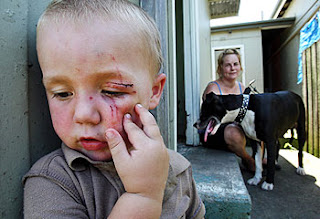 |
| (source) |
So much going on I need to take three deep breaths to calm down!
Firstly - we have a winner! Actually - thanks to the awesome crew at SPARCS, we have two! Very excited to meet Marsha P and Kristi M at #SPARCS2014 and want to thank all the excellent people who responded to our giveaway shoutout on Facebook, Twitter and Google+. We hope those of your who werent successful will consider still coming along or joining us on the livestream broadcast.
Secondly - I loved learning about the differences in UK and US shelter workers perceptions of pit bulls and all the associated bits and pieces that went along with that in our latest guest post by Dr Christy Hoffman. Really, really interesting research and I look forward to the next piece of the puzzle (aka new science) in that area.
 Thirdly - its dog bite prevention week in the USA right now! We cant all own Tara the Hero Cat (and to be fair, as much as she is worthy of her notoriety and 20million+ hits on the viral video showcasing her ninja skills, she didnt actually prevent the bite - although Im pretty confident she helped prevent it being a whole lot worse). If you somehow missed what on earth Im talking about - check out this clip of amazing Tara (but a warning, it does show security camera footage of a child being attacked by a dog and the subsequent wounds):
Thirdly - its dog bite prevention week in the USA right now! We cant all own Tara the Hero Cat (and to be fair, as much as she is worthy of her notoriety and 20million+ hits on the viral video showcasing her ninja skills, she didnt actually prevent the bite - although Im pretty confident she helped prevent it being a whole lot worse). If you somehow missed what on earth Im talking about - check out this clip of amazing Tara (but a warning, it does show security camera footage of a child being attacked by a dog and the subsequent wounds):Which brings us back to Dog Bite Prevention Week. We dont have a week like this in Australia, so I did some web trawling to check out what you guys have going on over there.
The AVMA have put up a whole lot of great information and resources about dog bite prevention, including this neat summary infographic:

I was really pleased to see this analysis of information about the role of breed in dog bite risk and prevention, which reminded me of this piece on The Conversation by researcher Dr Rachel Casey from Bristol University in the UK, who has been part of a team investigating aggressive behaviour in dogs.
The broader research in this area (see below for references) highlights similarities across Australia, the UK and the US with most serious dog bites occurring to children by a known dog in a familiar area without direct adult supervision at the time of the attack. But of course - as Hero Cat Tara has shown us this week, not all dogs stick to these trends.
It seems that there are many commonalities to serious dog bites that we can all be aware of to help reduce the risk, given that any dog can bite:
- Supervise children <14yo around dogs, even known dogs
- Dont try to pat a dog you dont know, even if it is on the other side of a fence
- Make sure your dog is well socialised and trained in basic commands
- Keep your dog healthy
- Teach your children to be mindful and careful of their actions around dogs, especially when the dog is tied up, eating or sleeping
- If you are threatened by a dog, remain still and calm with your hands balled by your sides - dont run
- If you are attacked by a dog, curl up in a ball and protect your face
Im off to reinforce messages of safe dog interacting with my pre-school aged daughter now - hope you have a great week.
Only one month til #SPARCS2014! Squee!
Mia
Further reading:
Meints K. & de Keuster T. (2009). Brief Report: Dont Kiss a Sleeping Dog: The First Assessment of "The Blue Dog" Bite Prevention Program, Journal of Pediatric Psychology, 34 (10) 1084-1090. DOI: 10.1093/jpepsy/jsp053
Schalamon J., Ainoedhofer H., Singer G., Petnehazy T., Mayr J., Kiss K. & Höllwarth M.E. (2006) Analysis of dog bites in children who are younger than 17 years., Pediatrics, PMID: 16510617
Keuster T.D., Lamoureux J. & Kahn A. (2006). Epidemiology of dog bites: A Belgian experience of canine behaviour and public health concerns, The Veterinary Journal, 172 (3) 482-487. DOI: 10.1016/j.tvjl.2005.04.024
Langley R.L. (2009). Human Fatalities Resulting From Dog Attacks in the United States, 1979–2005, Wilderness & Environmental Medicine, 20 (1) 19-25. DOI: 10.1580/08-WEME-OR-213.1
Ozanne-Smith J. (2001) Dog bite and injury prevention--analysis, critical review, and research agenda, Injury Prevention, 7 (4) 321-326. DOI: 10.1136/ip.7.4.321
Thompson P. (1997). The public health impact of dog attacks in a major Australian city., The Medical Journal of Australia, 167 (3) 129-132. PMID: 9269266
Schalamon J., Ainoedhofer H., Singer G., Petnehazy T., Mayr J., Kiss K. & Höllwarth M.E. (2006) Analysis of dog bites in children who are younger than 17 years., Pediatrics, PMID: 16510617
Keuster T.D., Lamoureux J. & Kahn A. (2006). Epidemiology of dog bites: A Belgian experience of canine behaviour and public health concerns, The Veterinary Journal, 172 (3) 482-487. DOI: 10.1016/j.tvjl.2005.04.024
Langley R.L. (2009). Human Fatalities Resulting From Dog Attacks in the United States, 1979–2005, Wilderness & Environmental Medicine, 20 (1) 19-25. DOI: 10.1580/08-WEME-OR-213.1
Ozanne-Smith J. (2001) Dog bite and injury prevention--analysis, critical review, and research agenda, Injury Prevention, 7 (4) 321-326. DOI: 10.1136/ip.7.4.321
Thompson P. (1997). The public health impact of dog attacks in a major Australian city., The Medical Journal of Australia, 167 (3) 129-132. PMID: 9269266
© Do You Believe in Dog? 2014

































